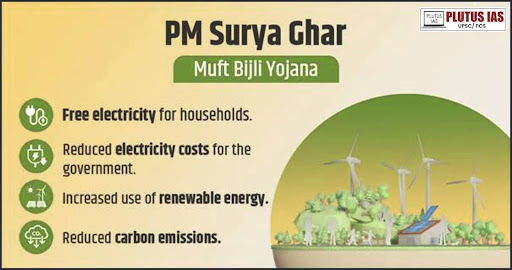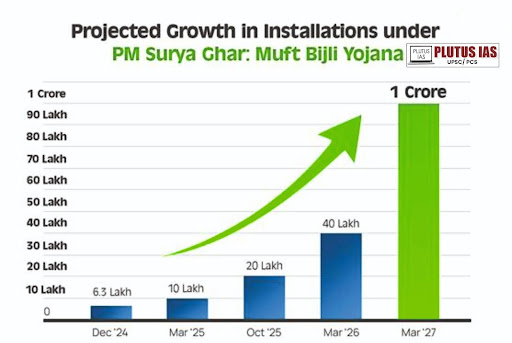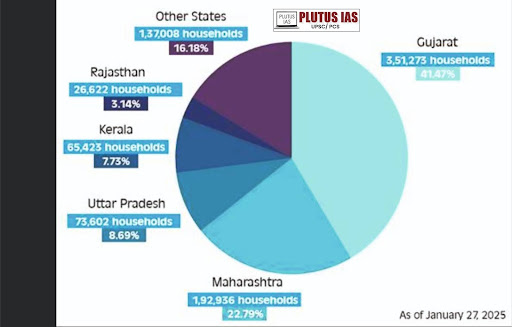13 Feb PM Surya Ghar Yojana: Transforming India’s Energy Landscape
This article covers “Daily Current Affairs,” and the topic details related to “PM Surya Ghar Yojana: Transforming India’s Energy Landscape”
Syllabus mapping:
GS-3: Environment: Renewable energy and related schemes.
For Prelims:
Key Facts about PM Surya Ghar: Muft Bijli Yojana (PMSGMBY). Green Hydrogen Mission, National Nuclear Energy Mission.
For Mains:
PM Surya Ghar Yojana: impacts, challenges, and significance. Various government initiatives to promote clean energy, challenges in adopting clean energy, and ways to address these changes.
Why in the News?
On February 13, 2025, PM Surya Ghar: Muft Bijli Yojana (PMSGMBY) marks its first anniversary, celebrating a year of empowering households with affordable solar energy and advancing India’s sustainable energy transition. Launched by Prime Minister Narendra Modi on February 13, 2024, this initiative aims to provide free electricity through rooftop solar panel installations.

What is PM Surya Ghar: Muft Bijli Yojana (PMSGMBY)?
Prime Minister Narendra Modi launched the PM Surya Ghar: Muft Bijli Yojana (PMSGMBY) on February 13, 2024. It is the world’s largest domestic rooftop solar initiative. By facilitating rooftop solar panel installations, it aims to provide free electricity to households, making renewable energy more accessible and affordable.

Key Achievements of PM Surya Ghar: Muft Bijli Yojana

| Metric | Details |
|---|---|
| Households Benefitted | 8.46 lakh (as of January 27, 2025) |
| Installation Growth | Tenfold increase in monthly installations, now averaging 70,000 per month |
| Subsidy Support | Up to 40% subsidy to make solar energy affordable |
| Financial Assistance | ₹4,308.66 crore disbursed as Central Financial Assistance (CFA) to 5.54 lakh residential consumers |
| Average Subsidy Per Household | ₹77,800 |
| Zero Electricity Bills | 45% of beneficiaries now enjoy zero electricity bills based on their solar power generation and consumption patterns |
Eligibility

Benefits of PM Surya Ghar: Muft Bijli Yojana
Household Savings & Income Generation – Households benefit from lower electricity bills and can earn revenue by selling surplus solar power to DISCOMs. A 3-kW system can generate over 300 units per month, ensuring energy security and potential earnings.
Expansion of Solar Capacity – The scheme aims to add 30 GW of rooftop solar capacity in the residential sector, significantly accelerating India’s renewable energy transition.
Boost to Renewable Energy Goals—This supports India’s commitment to achieving 500 GW of non-fossil fuel energy capacity by 2030, strengthening energy sustainability.
Environmental Impact—Over its 25-year lifetime, the scheme is expected to generate 1000 BUs of electricity and reduce CO₂ emissions by 720 million tonnes, helping combat climate change.
Job Creation – Expected to create 17 lakh direct jobs in manufacturing, logistics, supply chain, sales, installation, and operations & maintenance (O&M), fostering economic growth.
Energy Security & Grid Stability – Decentralized rooftop solar installations will reduce transmission losses, enhance grid stability, and decrease reliance on fossil fuels.
Lower Dependence on Conventional Power – Reduces demand on coal-based power plants, leading to a cleaner energy mix and improved air quality.
Empowerment of Rural & Urban Households – Provides affordable, reliable, and sustainable energy solutions to both urban and rural households, improving their overall quality of life.
Key Renewable Energy & Electrification Initiatives in India
| Programme | Launched Date | Key Objectives |
|---|---|---|
| International Solar Alliance (ISA) | 2015 | Global alliance to promote solar energy adoption and reduce fossil fuel dependency. |
| Solar Energy Corporation of India (SECI) | 2011 | Implements grid-connected rooftop solar projects in partnership with the Education Ministry. |
| Solar Parks Scheme | 2014 | Establishes solar parks & ultra-mega solar power projects across India. |
| Bhaskara Advanced Solar Energy (BASE) Programme | 2013 | Supports the development of students and scientists in solar energy research. |
| Renewable Energy Certificate (REC) Scheme | 2010 | Allows renewable energy producers to sell certificates to distribution firms and industries. |
| Green Hydrogen Mission | 2023 | Promotes the production and adoption of green hydrogen as a clean energy alternative. |
| Perform, Achieve & Trade (PAT) Scheme | 2012 | Enhances energy efficiency in energy-intensive industries through tradable energy-saving certificates. |
| Pradhan Mantri Sahaj Bijli Har Ghar Yojana (SAUBHAGYA) | 2017 | Ensures affordable and reliable electricity for all rural and urban households. |
| Ujjwala Scheme (PMUY) | 2016 | Provides free LPG connections to poor households, reducing dependence on traditional fuels. |
| Green Energy Corridor (GEC) | 2013 | Integrates renewable energy into India’s national transmission grid for stable power supply. |
| Indian Renewable Energy Development Agency (IREDA) | 1987 | Provides financial support for renewable energy and energy conservation projects. |
Challenges in India’s Clean Energy Transition
| Challenges | Details |
|---|---|
| High Installation Costs | Solar panel installation remains expensive, limiting widespread adoption. |
| Coal Dependency | India still relies on 60% coal-based energy, slowing the renewable transition. |
| Financial Constraints | Shortage of financial resources and high upfront costs hinder clean energy projects. |
| Land Acquisition Issues | Difficulties in acquiring land, especially for wind farms in populated areas. |
| Grid Integration | Renewable energy fluctuations require significant grid upgrades for stability. |
| Energy Storage | Limited storage solutions make managing intermittent solar & wind power challenging. |
| Infrastructure Limitations | Existing power infrastructure struggles to handle large-scale renewable energy. |
| Regulatory Hurdles | Lack of clear policies discourages investment in clean energy projects. |
| Technical Expertise | Shortage of skilled professionals for design, implementation & maintenance. |
| Social & Environmental Concerns | Addressing community and ecosystem impacts of renewable projects. |
| Public Awareness | Need to educate people on clean energy benefits & adoption. |
Strategies to Promote Clean Energy in India
| Strategies | Implementation |
|---|---|
| Enhancing Grid Connectivity | Strengthening transmission networks for efficient renewable integration. |
| Solar Rooftop Mission | Expanding rooftop solar to reduce individual household electricity needs. |
| PM Surya Ghar Yojana | A game-changer for marginalized and low-income groups. |
| Modern Solar Village Programme | Supporting rural areas in becoming self-reliant through solar energy. |
| Boosting Private Sector Participation | Encouraging domestic & foreign companies to invest in large-scale renewable projects. |
| Expanding Financial Incentives | Providing low-interest loans, subsidies, & tax benefits for clean energy projects. |
| Strengthening International Collaboration | Partnering with USA, Denmark, Germany & Japan for technology transfer & joint projects. |
| Research & Development in Storage Solutions | Focusing on battery storage, hydrogen fuel & smart grids for energy efficiency. |
| Reducing DISCOM Burden | Implementing reforms to ease financial pressure on power distribution companies. |
| Promoting Nuclear Energy | Strengthening the National Nuclear Mission for alternative power sources. |
| Exploring Geothermal Energy | Harnessing Puga Valley (Himachal Pradesh) for geothermal energy production. |
| Developing Offshore Wind Energy | Expanding offshore wind farms to utilize India’s vast coastline for clean power. |
Conclusion
The PM Surya Ghar: Muft Bijli Yojana is revolutionizing India’s energy landscape by empowering households with solar power. With installations set to exceed 10 lakh by March 2025, 20 lakh by October 2025, and 40 lakh by March 2026, the scheme is on track to achieve its ambitious one crore target by March 2027. By saving the government ₹75,000 crore annually, reducing carbon emissions, and creating jobs, the initiative cements India’s leadership in clean energy.
Prelims Question:
Q. Consider the following statements regarding the PM Surya Ghar: Muft Bijli Yojana (PMSGMBY):
1. PMSGMBY is a central sector scheme.
2. To avail of the benefits of PMSGMBY, a person must be a citizen of India.
3. PMSGMBY aims to reduce GHG emissions by reducing the coal-based energy demand.
How many of the above-given statements are correct?
(a) Only one
(b) Only two
(c) All three
(d) None
ANSWER: C
Mains question:
Q. To what extent can rooftop solar initiatives like PMSGMBY contribute to India’s net-zero target? Examine the challenges and suggest measures for effective implementation.
(Answer in 250 words)




No Comments